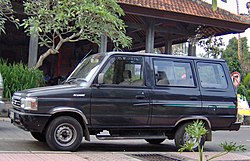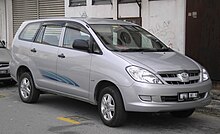Toyota Kijang
| Toyota Kijang | |
|---|---|
| Manufacturer: | Toyota |
| Production period: | 1977-2006 |
| Previous model: | none |
| Successor: |
Toyota Innova Toyota Kijang Innova Toyota Revo |
The models Kijang (Indonesia), Condor (South Africa), Qualis (India), Revo (Philippines), Tamaraw (Philippines), Unser (Malaysia), Venture (South Africa), Z-Ace (Taiwan and Vietnam), Zace (Taiwan) and Zaice (Vietnam) are models of the Japanese brand Toyota , which go back to the Toyota Kijang developed by Toyota Indonesia and which became a worldwide success. These models were particularly in demand in Southeast Asia and South Africa as well as on some Caribbean islands. Countless CKD orders had to be awarded to independent workshops in order to meet the increasing demand. In 2003/2004 the Kijang was finally abandoned in some markets and replaced by other models in some.
Model overview
First generation
| Kijang (1977–1980) Tamaraw (1978–1982) |
|
|---|---|
| Image does not exist | |
| Production period: | 1977-1982 |
| Designs: | Minibus , box truck , flatbed truck |
| Engines: |
Petrol engines : 1.2-1.6 liters (57-65 kW) |
The Kijang was developed by Toyota Indonesia in the early 1970s based on the proven Toyota Land Cruiser . A cheaper off-road vehicle that was better suited for the Indonesian market was to be built. Despite initial skepticism - the Land Cruiser was a tried and tested model - the first planning began under secrecy in 1973. After two years of development, the models were finally shown to the world for the first time at the Jakarta Fair Show . Series production was not considered by Toyota until then, as the Land Cruiser was considered unbeatable. The great response and the receipt of thousands of written inquiries quickly changed this opinion and it was finally possible to start series production of the Toyota Kijang in Indonesia in 1977 . A year later, CKD kits were also delivered to a Filipino company. There the model was built as a Toyota Tamaraw.
There were four different body styles to choose from, as well as various engines. The Kijang was available as a minibus , Pikap with one or , if desired, with 2 cabins. A panel van was also available. The Filipino Tamaraws also had long versions of the pick-up and a truck version with a tarpaulin frame.
As motorization there was the 1.2-liter 3K - petrol engine with 57 kW (77 hp). With the Filipino model, the model selection was far greater. The Toyota 4K engine with 65 kW (89 PS) was also available here. Other engine manufacturers offered the 1.3-liter Pinoy engine ( Ford Motor Company ) and the 1.6-liter Fiera I, Fiera II and Fiera III engines (also from Ford). Chrysler-Mitsubishi had the 1.4-liter Neptune engine. This was also used a little later for the Kijang
In 1980 the Kijang was finally revised and the second generation was established. In the Philippines, the Tamaraw was built in its original form until 1982 and also replaced by the second generation.
The Tamaraw's only competitor was the Jeepney . A total of 26,806 units of the Kijang were produced.
Second generation
| Kijang (1980–1986) Tamaraw (1982–1991) Z-Ace (1982–1993) |
|
|---|---|

|
|
| Production period: | 1980-1993 |
| Designs: | Minibus , box truck , flatbed truck |
| Engines: |
Otto engines : 1.4–1.5 liters. Diesel engines : 2.2–2.5 liters |
With the introduction of the second generation, the Kijang and Tamaraw were given a design that gave the models a more massive appearance. Nevertheless, the shape was still very similar to its predecessor. The headlights were either oval, round or angular.
The only engine for the Kijang was the 1.4-liter 4K engine. In 1985 this was replaced by a 1.5-liter gasoline engine.
With the Tamaraw, however, a 2.2-liter diesel engine from Delta Motors was standard. From Mazda gave it for a second engine choice a 2.5-liter diesel engine. Other engines in the range of the Tamaraw were the Fiera IV from Ford and the Isuzu C-190.
Dragon Motor Vehicles , a local Filipino automaker, bought a license following the success of the Tamaraw. Shortly thereafter, the company produced independent models under the brand name Dragon . Also Nissan and Carter Motors have recognized the popularity of the model and also bought the rights to the design. This is how the competing models Nissan Bida , which was distributed by Universal Motors, were also created; as well as the Carter Masa .
These were now also a direct competition, so that a newer and more modern successor had to be created. Although a new version was launched in 1986, the new generation did not arrive in the Philippines until 1991.
The Z-Ace models built in Taiwan and Vietnam were identical to the Indonesian Kijang.
Third generation
| KF-40 / KF-50 | |
|---|---|

Toyota Kijang |
|
| Production period: | 1986-2005 |
| Designs: | Minibus , box truck , flatbed truck |
| Engines: | |
The third generation from 1986 differed considerably from its predecessors. So now the body shape was contemporary again and the vehicle could be ordered with far more extras. The model also became interesting for private households. The previous generations were almost exclusively sold to traders and traders.
In this way, the model has now also become known in Africa and the Caribbean. Demand there was also very high, so this generation was now also being built in South Africa as a Toyota Venture . These were eventually exported to other African countries and the Caribbean.
In the Kijang model series, the model differed primarily in length. There was a KF-40 series with a short wheelbase and the KF-50 series with a long wheelbase. The simplest model variant was the standard Kijang . The best version was the Super Kijang . The pickup version of the new generation was commissioned from independent workshops and was based on the Toyota Hilux . The design was designed uniformly so as not to deviate from the minibus version.

In 1992, minor stylistic changes were made to the model. The units from the Toyota factory were identified with the Toyota Original Body logo . The interior has also been slightly redesigned, although the standard was still the entry-level model. This was particularly popular for traders. The Deluxe was one floor higher . The top model was the Grand Extra . The Kijang was powered by the 1.8-liter 7K-C engine.
With the Tamaraw FX, however, there were various variants of gasoline and diesel engines. These were also offered by the Malay Unser and the Zaice. Like the Zace and the Kijang, the Venture was initially identical. With the introduction of the Qualis on the Indian market, more engines were developed. These developed 61 kW (83 PS) and 75 kW (102 PS). They eventually replaced all engines previously offered by the Venture as well as the Zaice and Zace. The quality was technically the same, but the front section was unique and is a previous version of the fourth generation.
The Indonesian facelift version was finally offered as the fourth generation in the Tamaraw FX from 1993. The Vietnamese Zaice was adapted to the 1996 model accordingly. In the independent workshops, body parts from the Mazda MPV were often used for the body of the Toyota Unser .
Fourth generation
| Series 60/70/80 | |
|---|---|

Toyota Our |
|
| Production period: | 1996-2006 |
| Designs: | Minibus , box truck , flatbed truck |
| Engines: |
Diesel engines : 1.8–2.4 liters |
With the fourth generation or the second Tamaraw FX generation, the design was modernized again. However, this was not offered in some markets. The third generation was still on offer there.
In the coding, the pickup version was now referred to as Series 60. The minivan, also popularly known as the Kijang Capsule, was the Series 70 and the long version was the Series 80. The Kijang was powered by either a 1.8-liter gasoline engine or a 2.4-liter diesel engine.
Series 60 Standard Deck Model Overview :
- SX , standard model
- SSX , equipped with radio and cassette player or cassette radio
- SGX , equipped with cassette or CD radio, power windows and decor
- Rangga , sports version with SGX equipment
Series 60 Flat Deck Model Overview :
- LX , standard model
- LSX , equipped with radio and cassette player or cassette radio
- LGX , equipped with cassette or CD radio, power windows and decor
- Krista , sports version with LGX equipment
Series 70 model overview :
- SX , standard model
- SSX , equipped with radio and cassette player or cassette radio
- SGX , equipped with cassette or CD radio, power windows and decor
Series 80 model overview :
- LX , standard model
- LSX , equipped with radio and cassette player or cassette radio
- LGX , equipped with cassette or CD radio, power windows and decor
- Krista , sports version with LGX equipment
In 2000 the Kijang got a little lift at the front and rear. A 2.0-liter engine was now also available for the LGX and Krista model versions. The interior of these two model versions has also been slightly revised. Another slight revision took place in 2003. These model versions are now also divided into A (1997–2000), B (2000–2003) and C (2003–2005). When the Kijang series had developed into a passenger car over time, Toyota India and Toyota Indonesia decided to develop a suitable successor. This was established in 2005 and bears the names Toyota Innova (India), Toyota Kijang Innova (Indonesia) and Toyota Revo (2nd generation; Philippines) , depending on the market .
Sources and web links
- History website of the Kijang (Indonesian, English)
- Toyota Motor Corporation Official Website (Japanese)
- Official website of Toyota South Africa (English and Afrikaans)

